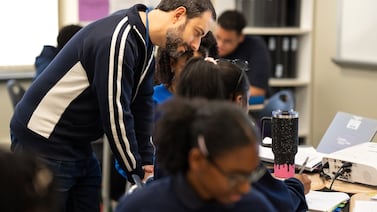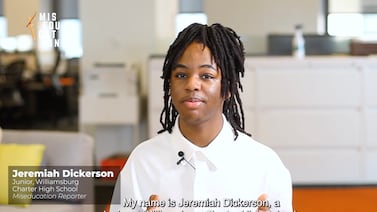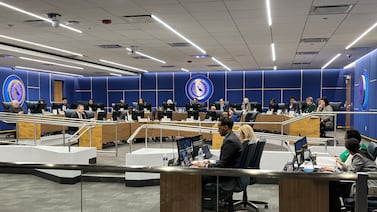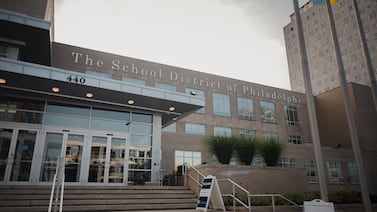In a major shift for high school admissions, eighth graders from across the five boroughs with course grades in the top 15% of their class last year will have priority in scoring seats at some of New York City’s most selective high schools, Chancellor David Banks said Thursday.
Middle schools, meanwhile, will once again be allowed to screen students based on grades and other metrics for the first time since before the pandemic, Banks added.
The move marks a departure from the past few years when the pandemic upended many of the selective admissions criteria, forcing changes to admissions that helped move the needle on integrating one of the most segregated school systems in the nation. Integration advocates said those changes increased the share of Black, Latino and low-income students admitted to some of the city’s most selective schools. According to limited data from the education department, the changes increased the proportion of Black and Latino students at several high-demand schools.
Banks said the revamped admissions process, which immediately sowed confusion among families, aims to strike a balance between “increasing access to communities who have historically been locked out of screened schools,” while also “rewarding those who work hard academically and make it to the top of their middle school class.”
The high school change applies to roughly 100 schools that have in the past used selective admissions criteria such as grades, test scores, and attendance. It does not apply to about 20 of the most coveted selective schools — like Beacon High School and Bard Early College — that have their own assessments like essays or school-based tests.
For middle school admissions, the city will allow each district’s superintendent to work with the community to decide what, if any, selective admissions criteria to use in screening applications.
“We are not eliminating screens,” said Banks. “The previous administration sought to take these opportunities away. I have heard overwhelmingly across the city, parents have asked us to increase opportunity, not take it away.”
For high schools, the new plan represents a big change from last year’s policy, under which students needed at least an 85 grade point average to be in the top tier for selective schools — and roughly 60% of eighth graders qualified, said Sarah Kleinhandler, the head of enrollment for the education department. With this year’s changes requiring at least a 90 average, roughly 20% are expected to have priority.
“If a young person is working their tail off every single day and they get a 99% average … that should be honored,” Banks said. “I don’t want to de-incentivize hard work. … I think it’s really important that if you’re working hard and making the grade, you should not be thrown in a lottery with just everybody.”
For middle schools, screens could be coming back after they were paused altogether for the past two years. Middle school applications open on Oct. 26, giving superintendents a short timeline to work with communities on creating changes and then explaining those changes to families.
High school applications open Oct. 12. Applications for middle and high school are due Dec. 1. High school offers are expected to be shared in early March, while middle school offers are expected in April.
The city’s selective schools are separate from the eight specialized schools that require the Specialized High School Admissions Test. Admissions for those schools remain unchanged. Registration for the test opens Oct. 6. The exam will be given to eighth graders in their middle schools on Nov. 17, as well as the weekend of Nov. 19.
For performing arts schools, auditions will remain virtual.
A closer look at the high school changes
At the high school level, former Mayor Bill de Blasio’s administration eliminated a special geographic priority for students in Manhattan’s District 2, and shifted screened admissions rules last year to reduce the importance of the very top grades.
This year, eighth graders at the top of their class last year — or in the top 15% citywide — must also have scored an average of at least 90 in their seventh grade core subjects to have priority to the selective high schools, according to the new admissions criteria.
Students will qualify for the top tier if they score in the top 15% of their individual school, or in the top 15% of all city eighth graders – whichever cutoff is lower. That means at some high-performing middle schools with lots of students with high grades, more than 15% of students will qualify.
The DOE didn’t immediately say how many overall seats are available in screened high schools or how many students are expected to qualify for top tier admissions priority this year.
If there are more top applicants than seats at a screened school, applicants will be selected based on a lottery, Kleinhandler said.
In another significant change to high school admissions criteria, screened programs will no longer consider state standardized test scores when selecting students.
Banks said he believes the state exams “can be flawed in terms of admissions criteria” and that grades are a better predictor of how students will fare in screened high schools.
It wasn’t immediately clear how the changes to high school admissions rules would impact long-running efforts to increase the number of Black, Latino, and other underrepresented students at selective high schools.
Education department spokesperson Nathaniel Styer said the agency is projecting that the changes will increase the racial and socioeconomic diversity of students admitted to screened schools compared to before the pandemic, but not compared to last year, when a wider range of students got first priority to screened schools.
The DOE didn’t immediately provide those specific projections.
The high school changes drew qualified praise and criticism from both supporters and opponents of admissions screens.
Nyah Berg, the executive director of New York Appleseed, a group that has pushed to eliminate screens, applauded the DOE for “standardizing the selection criteria” and making the admissions process more “transparent.” But she said she’s not satisfied with reforms she views as the “bare minimum” and that “will undoubtedly result in less diverse schools.”
John Liu, a state senator from Queens who was critical of de Blasio’s pandemic admissions reforms, praised the decision to “narrow” the group of students receiving admissions priority compared to last year, but said it “remains unclear if the administration’s efforts … fosters true educational achievement and equity.”
Parents of current eighth graders, meanwhile, were scrambling to figure out what the changes mean for their kids.
Gwen Leifer, the parent of an eighth-grader at Stephen Halsey Junior High School in Forest Hills, Queens, said this year’s system is an “improvement” over last year’s. “You couldn’t plan, couldn’t strategize how to rank things,” last year, she said. “I think this lets people make more rational choices.” Leifer, whose son is interested in arts schools, said she also appreciates that auditions will remain virtual.
Schools that were already participating in “diversity in admissions” programs that allow them to set aside a portion of seats for underrepresented students will be allowed to continue with those initiatives, Kleinhandler said.
Additionally, the city plans to open three new schools in September 2024 focused on “accelerated learning” in low-income communities of color — in the South Bronx, Ocean Hill-Brownsville, and Southeast Queens — giving students from these neighborhoods geographic priority so they don’t have to travel long distances for such programs.
Middle school changes a work in progress
While some families lobbied to restore selective admissions criteria for middle school, integration advocates had pushed to eliminate them, saying it is unfair to sort fifth graders based on their academic performance from fourth grade.
Superintendents are expected to work with their communities to determine whether to use selective middle school admissions criteria. If they choose to do so, students would be ranked on their fourth grade scores. Still, city officials said they would limit the number of schools using academic screens.
When asked which specific types of admissions criteria middle schools could use, and whether attendance could be a factor, Kleinhandler said, “we would entertain everything that’s brought to the table.”
Banks added, “This is a community decision that will be led by the community when it comes to middle school admissions.”
Superintendents are supposed to make decisions about any new middle school screens before applications open on Oct. 26, giving them under a month.
New York City Comptroller Brad Lander, who was a city councilperson representing Brooklyn’s District 15 when it passed a middle school diversity plan eliminating screened schools in favor of a lottery-based system, said he was relieved that plan will remain in place. The district’s community education council already passed a resolution in support of keeping it.
But Lander was disappointed the initiative would not be replicated citywide.
“Unfortunately, today’s announcement walks back the commitment to move forward across the city toward that vision — despite local law that requires more districts to engage in diversity planning,” Lander said in a statement. “Restoring middle-school screens will reinforce segregation in our schools. It elevates the notion that some children deserve ‘good schools’ while the vast majority do not.”
Sheree Gibson, Queens Borough President Donovan Richards’ appointee to the city’s Panel for Educational Policy, said she’s worried whether the superintendents can meaningfully survey parents and communicate their decisions under such a tight timeline.
“Are you going to truly represent what your community wants to do or are you just going to represent some of the louder voices in your community?” she asked.






